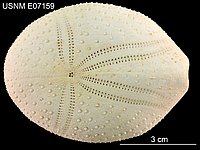|
Eurypatagidae
Kroh, 2007
Hemipatagus, a
misinterpreted loveniid, p.174
Genre type :
Eurypatagus Mortensen,1948
Description succinte de la famille : tax. cf.
Lambert (1905) pour Platybrissinae (mis en
synonymie : paraphylétique)
Notes sur quelques Échinides
éocéniques de l'Aude et de l'Hérault, p.162
Pas de fascioles
chez l'adulte, plaques sternales lisses, pétales ouverts et rétrécis,
s'étendant jusqu'à l'ambitus, labre très allongé, allant jusqu'aux
quatrièmes plaques A I et 5.
|
|

 |
|
|
|
 |
|
|
|
|
| |
Genre
Eurypatagus
Mortensen,1948,
p.133
Contributions to the
Biology of the Philippine Archipelago and adjacent regions. Report on the
Echinoidea collected by the United States Fisheries Steamer "Albatross"
during the Philippine Expedition, 1907-1910. Part 3: The Echinoneidae,
Echinolampidae, Clypeastridae, Arachnidae, Laganidae, Fibulariidae,
Urechinidae, Echinocorythidae, Palaeostomatidae, Micrasteridae,
Palaepneustidae, Hemiasteridae, and Spatangidae
Espèce type
Eurypatagus ovalis
Mortensen, 1948, p.133
(désignation originale)
ibid.
Extension
stratigraphique
(bibliographique, non vérifiée)
: Actuel |
|
|
|
|
|
diagnose originale du
genre par Mortensen, 1948, p.133 |
|
|
|
EURYPATAGUS, new genus
Test low, arched : oral side
flat, but sunken at the
peristome. Outline elliptival,
no groove or depression in the frontal
edge ; the posterior end slightly produced. Paired ambulacra distinctly
petaloid, continuing to the edge of the test,
open distally ; frontal ambulacrum very narrow, the pores very small. The phyllodes of the anterior paired ambulacra very conspicuous, with 12-14 pores (tube
feet) in each series, each accompanied by a
sphaeridium. Peristome broad, pentagonal, rather
far from the anterior edge. Labrum well developed, with a narrow posterior prolongation ending off the middle of plates No. 4 of the
adjoining ambulacral
series. Plastron very small, entirely naked, or at most with a very few tubercles (spines) at the
posterior end. The 3 or 4 ambulacral plates
adjoining the episternal plates adproctally
prolonged, indicating the presence of a subanal fasciole in the young specimens ; but there is no trace of such fasciole in the adults. No internal or
peripetalous (or marginal) fasciole. Periproct placed vertically on the posterior end of the test, somewhat
produced upward and
visible from above. Apical system anterior; 4
genital pores. Primary
tubercles of the aboral side not very conspicuous, scattered all over
the interambulacra, also the posterior unpaired interambulacrum : on the
sides of the test they may be distinctly arranged in horizontal series.
The primary spines curved
at the base, directed
backward, with a few distant serrations ; secondary spines curved.
Tridentate, rostrate, and
triphyllous pedicellariae present ; but none of the globiferous type. Ophicephalous pedicellariae found in the young of one species (paucituherculatus)
. Color of test red,
spines red or banded or yellowish. The denuded test white.
Genotype :
Eurypatagus ovalis,
new species.
The genus
is nearly related to Maretia but differs from it in the open petals, the
stronger development of the phyllodes, the
greater posterior prolongation of the labrum, and the almost totally naked sternum. It is more nearly related to
Platybrissus, from which it differs mainly in the character of the
peristome. |
|
|
|
| |
Eurypatagus ovalis
Mortensen,1948 |
|
|
|
|
|
diagnose originale de
l'espèce par Mortensen, 1948 |
|
Contributions to
the Biology of the Philippine Archipelago and adjacent regions. Report on
the Echinoidea collected by the United States Fisheries Steamer "Albatross"
during the Philippine Expedition, 1907-1910. Part 3: The Echinoneidae,
Echinolampidae, Clypeastridae, Arachnidae, Laganidae, Fibulariidae,
Urechinidae, Echinocorythidae, Palaeostomatidae, Micrasteridae,
Palaepneustidae, Hemiasteridae, and Spatangidae, p.134 |
|
|
|
EURYPATAGUS
OVALIS, new
species
Locality.—Station 5217 (13°20' N., 123°14' E.) ;
192 meters; April 22, 1908. Five well-preserved specimens.
Type.—U.S.N.M. No. E.7159,
from station 5217.
Description.—The largest specimen is 88 mm. long, 66 mm. broad, and 26 mm. high ; the smallest is 71 mm. long, 55 mm. broad, and 20 mm. high. The above description of the genus Eurypatagus applies equally to the species ovalis; a more detailed description therefore need not be given here. A full description, with illustrations, will be given in volume 5 of the Monograph of the Echinoidea. It may be stated here only that the tridentate
pedicellariae occur in two forms, a large form, up to 1.5
mm. in length of head, with very slender, slightly curved valves, wide apart, meeting only at the point, and a smaller form with broader, spoon-shaped valves. The spines are to a varying degree red-brown with lighter bands.
|
|
|
|
|
Holotype, conservé
au Smithsonian National Museum of Natural History |
|
in
Mortensen. 1948. Bull.
U.S. Nat. Mus. 14 (3): 129. |
|
|
| Catalog Number: |
USNM E 7159 |
| Collection Name: |
Mortensen 5217 |
| Crédit photo: |
USNM/Stefan Countryman |
| Date collected: |
22 avril 1908 |
| Collection Method: |
Trawl - Agassiz beam, 12 ft, with mud bag |
| Scientific Name (As Filed): |
Eurypatagus ovalis Mortensen, 1948 |
| Type Status: |
Holotype |
| EZID: |
http://n2t.net/ark:/65665/36f1a22b6-a7a9-4329-a7f2-51cbca12f59c |
|
|
|
|
|
|
|
| |
Eurypatagus ovalis
Mortensen,1948 - Actuel,
Philippines, près de Caubian Island, 200 m, 74 mm |
|
|
|
|
|
|
|
|
|
 |
|
|
|
|




